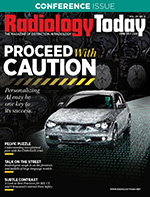 Editor’s Note: Heatwave
Editor’s Note: Heatwave
By David Yeager
Radiology Today
Vol. 25 No. 5 P. 4
Over the past six or seven years, no topic in radiology has been as hot as AI. Whether it’s used for enhancing workflow, detecting abnormalities, improving image quality, or decision support, AI is here to stay. In this issue, we’re offering a double dose of AI-related articles. No matter what they’re being used for, it seems clear that radiologists and medical imaging professionals need to learn more about these tools and how they may fit into current and future practice. The AI trend shows no signs of cooling down any time soon.
It has long been known that AI algorithms are only as good as the data they’re trained on, and the algorithms’ performance can change over time, depending on the types of cases they are used for. What hasn’t been addressed to any great degree is how users’ expertise and preferences may affect AI’s performance. Our cover feature takes a closer look at that variable. Studies have shown that the effectiveness of AI assistance for radiologists can vary widely, depending on several factors. Beth W. Orenstein asks the experts how to get better results from AI, and one answer may be to tailor it to the radiologists who use it.
Another area of AI that is ripe for optimization is the use of large language models (LLMs) to assist with text-based tasks. Orenstein explores potential uses for LLMs, which offer the potential to aid clinical tasks, improve reporting efficiency, and reduce burnout among radiologists. Given recent reporting in the national media about the types of errors that LLMs are prone to, it should come as no surprise that, as with other AI tools, the key to quality results lies in clearly specifying what a user wants. Many in the medical imaging field believe that, with some fine-tuning, LLMs will be a useful addition to radiology practices.
In IR news, a trial to explore treatments for pelvic pain in women was announced at this year’s Society of Interventional Radiology meeting. Pelvic pain can have many different causes, and it is challenging to treat. The trial, called EMBOLIZE, is intended to treat abnormalities in the pelvic veins, which may account for as many as 30% of pelvic pain disorders. The investigators undertaking the trial hope to shed light on the gaps that exist in pelvic pain research while enabling effective treatments. Rebecca Montz reports on the trial’s goals, methods, challenges, and anticipated outcomes.
Finally, Keith Loria has an update on the latest best practices in contrast dose safety. MRI, CT, and ultrasound each have specific use cases and challenges. Using the least amount of contrast necessary to get clinically useful images is always an important consideration, and new agents, as well as AI, are helping providers make the best use of these critical materials. Turn to page 22 for all of the details.
Enjoy the issue.

